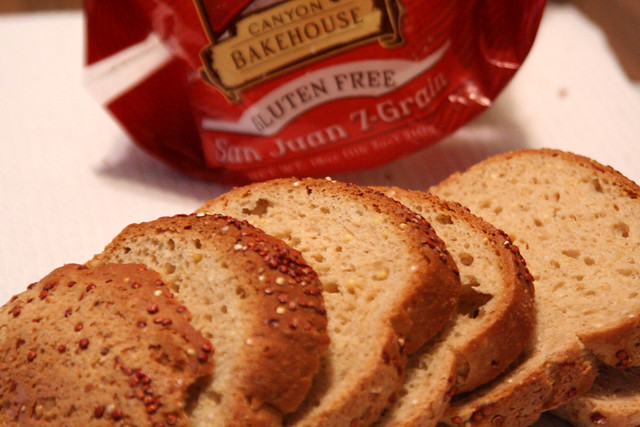 |
| Wheat |
Since May is Celiac Disease awareness month, I thought I'd do my bit. I don't really hold with awareness months, because generally the only people who are aware that it is an awareness month are the ones who are already aware of the disease...
I was diagnosed with Celiac Disease when I was seven after it was triggered by a bout of mono. If I hadn't been diagnosed, I would have died of starvation.
I was diagnosed with Celiac Disease when I was seven after it was triggered by a bout of mono. If I hadn't been diagnosed, I would have died of starvation.
Most
people haven’t the faintest what Celiac Disease is; Doctors and sufferers
included. It has no cure and no prevention; once you have it, it’s for life.
It’s not catching, because it’s genetic. If your parents both carry the gene,
there’s nothing you can do to avoid it.
Celiac
Disease is an autoimmune disease, which basically means it’s what happens when
your body starts attacking itself. Rheumatoid arthritis, Cancer and Crohn's
disease are other well-known autoimmune diseases; this is why you can develop
cancer even if you’ve never smoked a day in your life.
 |
| This image shows a normal cross-section of the small intestine (top) verses a celiac's small intestine after contact with gluten (bottom) |
When
I was seven, I couldn’t spell the name of my disease, but I knew full well what
it was and how it affected me. I lost weight, my hair was falling out, I
suffered from a fatigue so extreme I couldn’t climb the stairs. What was
happening inside of me was something close to science fiction. Because of the
altered chemistry of my intestines, a protein named gluten was slicing up my
insides like billions of tiny knives.
Gluten
is something akin to magic; it’s what hold’s dough together when you’re
kneading it. Gluten is an integral part of three grains: wheat, barley and rye.
By eliminating these three grains and all their verities, a
celiac sufferer can lead a relatively normal and painless life.
Of
course it’s not as easy as it sounds. Wheat, in particular, is the most
commonly used flour in the world. It’s wonderful stuff; you can make bread out
of flour, yeast and water and it won't fall apart, or go stale overnight; wheat is hardy and grows
beautifully, and if you eat the whole grain, you’ll have a very balanced and
healthy diet. Just eliminating bread isn’t enough, however, because wheat is used in everything from
shampoo to an additive in pepper.
Many
people are probably familiar with the label ‘Gluten Free’ that appears in
health food stores and specialty isles. Fortunately for us, companies dedicated
to gluten free food are increasing, but it’s still an expensive diet, mostly
because the companies, in order to appeal to as many people as possible, cater
to a number of different dietary restrictions like egg and nut allergies,
diabetes and lactose intolerance. The result is often disgusting.
 |
| Udi's is one of my favorite gluten free brands |
All
people need to do is hear the word ‘diet’ and they think it must be healthy,
however the gluten free diet is not healthy and its adherents often suffer from
vitamin deficiencies. If you don’t have
celiac disease or a related wheat sensitivity, don’t go on the diet; it’s not
worth it. There’s nothing in the world better for you than whole grain
wheat.
Celiac
disease is fairly common, affecting about one in every two hundred people. Italy has the highest percentage of celiacs
in the world; so if you have celiac disease and you want to go globe trotting, that might be the place to start. Many countries have rules and regulations regarding the
parameters that must be met in order for a product to be called gluten free.
The rule of thumb is three parts per million; which is basically three
particles of gluten per million particles. Any higher, and celiacs know it.
 |
| Canyon Bakehouse is another first rate gluten free bakery flickr |
Oats contain
gluten: Actually, oats contain a protein similar to gluten
and most people with celiac disease can tolerate it (not me, unfortunately);
however, the oats must be carefully processed from the field to the shelf, to
avoid cross-contamination. So to be on the safe side, avoid oats unless they
are specifically labelled ‘gluten-free’.
You are allowed to
cheat: Celiac disease is an affliction where no
cheating is allowed in the diet. Even if you have no symptoms, or very few, you
are still damaging your body. Adding ‘small’ amounts of gluten also won’t help
you ‘get over’ the disease. You cannot alter your genetics. If the correct diet is
maintained, celiac disease has a good prognoses, but if you cheat, you will
almost certainly develop cancer and/or diabetes.
Celiac Disease is an
allergy: This is one of the worst myths circulating. Celiac disease and allergies are both
autoimmune reactions, in that it is your immune system doing the damage. The
two often go hand in hand and are sometimes mistaken for each other, but they
are very different things.
 |
| Rice is the most common substitute for wheat, but it's lower in nutrients and makes terrible flour |
If
you think you have celiac disease, go see
a specialist. Primary care physicians are great, but I have yet to meet one
that actually knows what celiac disease is.
If you want more information about Celiac Disease, check out the Celiac Sprue Association. My
final line to all ye Celiac sufferers out there is; you are not alone.
~Psyche
No comments:
Post a Comment